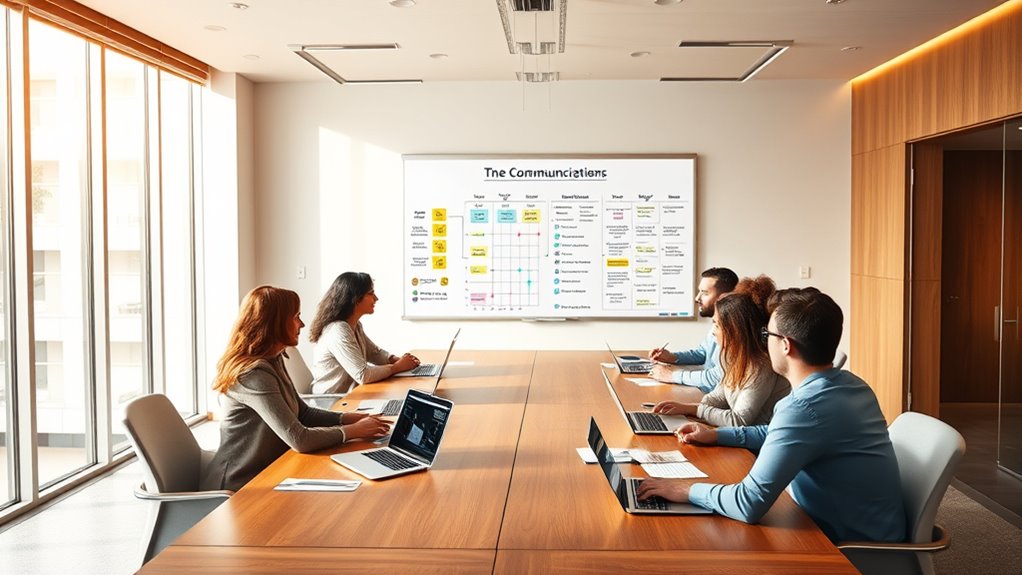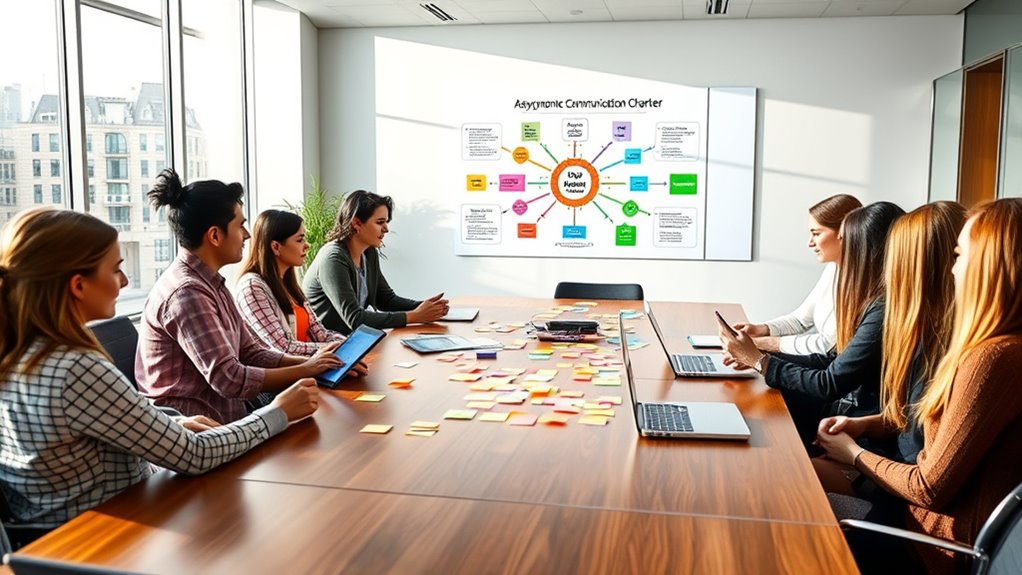To build an effective asynchronous communication charter, start by evaluating your team’s needs through feedback and observing how current practices work. Define clear response times, availability, and procedures for urgent messages. Choose appropriate channels for different types of communication and set guidelines for frequency. Clarify expectations for message content and tone to foster respect and clarity. Regularly review and update your policies to keep everyone aligned, and if you keep exploring, you’ll find ways to strengthen your team’s collaboration even further.
Key Takeaways
- Clearly define preferred response times and availability periods to set expectations for asynchronous communication.
- Select and assign specific tools or channels for different message types to streamline message flow and reduce confusion.
- Establish guidelines for message clarity, tone, and professionalism to promote respectful and effective communication.
- Regularly review and update the communication charter based on team feedback and evolving project needs.
- Ensure accessibility of the charter in shared platforms and promote team adherence through ongoing reinforcement.
Assessing Your Team’s Communication Needs

How do you determine if your team’s current communication methods are effective? Start by gathering team feedback to understand their experiences and frustrations. Are messages clear, timely, and accessible? Identify communication challenges that hinder productivity, such as missed messages, misunderstood instructions, or delays. Pay attention to patterns in feedback—do team members feel heard and informed? Assess whether your current tools and practices support collaboration or create bottlenecks. Recognizing these issues helps you pinpoint gaps in communication and prioritize improvements. By actively listening to your team’s input, you can develop a clearer picture of their needs and tailor your approach. This honest assessment ensures your communication strategies align with your team’s workflows, fostering a more efficient and cohesive environment. Additionally, understanding the Fokos platform’s features can help streamline your communication efforts.
Defining Guidelines for Response Times and Availability

Establishing clear guidelines for response times and availability is crucial to make certain your team communicates efficiently and respects each other’s schedules. Define response deadlines so team members know how quickly they should reply to messages, whether within hours or by the end of the day. Set availability standards to clarify when team members are accessible, such as specific working hours or designated quiet periods. These guidelines prevent misunderstandings, ensure timely collaboration, and help maintain work-life balance. Be explicit about expectations, including how to handle urgent messages and exceptions. Regularly review and adjust these standards based on team feedback and project needs. Clear response deadlines and availability standards foster accountability and create a smoother, more predictable communication flow. Incorporating effective communication practices can further enhance team coordination and responsiveness.
Establishing Clear Channels and Tools for Communication

Choosing the right communication channels and tools is essential for guaranteeing your team stays connected and productive. Clear channels prevent confusion and streamline collaboration. To do this effectively, consider tools that match your team’s needs and promote good digital etiquette. Establish specific platforms for different types of communication, like project updates or quick questions, and set guidelines on communication frequency to avoid overload. Make sure everyone understands where to post different messages to maintain clarity. Regularly review your tools to ensure they remain effective and user-friendly. Using vetted communication tools ensures reliability and security for your team’s information exchange. Clear channels and tools foster consistent, respectful communication, enabling your team to work asynchronously without miscommunication or frustration.
Setting Expectations for Message Content and Tone

Setting clear expectations for message content and tone is essential to guarantee effective and respectful communication within your team. By establishing guidelines for email etiquette, you ensure that messages are professional, courteous, and easy to understand. Encourage team members to be concise and specific, avoiding ambiguity that can hinder message clarity. Remind everyone to contemplate their tone, especially in written communication, to prevent misunderstandings or unintended offense. Clear standards help maintain consistency across messages, fostering a respectful environment where ideas flow smoothly. When everyone understands what’s expected, your team can collaborate more efficiently, reducing confusion and miscommunication. Additionally, emphasizing proper communication practices supports a healthy team dynamic and improves overall productivity. Ultimately, setting these expectations helps build a culture of transparency, professionalism, and mutual respect in your asynchronous communication.
Implementing and Maintaining Your Communication Charter

Once your team has agreed on standards for message content and tone, the next step is to put your communication charter into practice and keep it visible. Regularly reinforce the standards through feedback mechanisms, encouraging team members to share insights and improvements. Address cultural considerations by being mindful of diverse communication styles and adjusting your approach accordingly. To maintain your charter’s effectiveness, schedule periodic reviews to update guidelines as needed. Confirm everyone understands their roles in upholding standards and feels comfortable providing feedback. Keep the document accessible in shared spaces, such as your team wiki or project management tools. Consistent reinforcement and openness to feedback will help embed these practices into your team’s daily workflow, fostering a collaborative and respectful communication environment. Additionally, emphasizing the importance of clear ethical guidelines can help ensure responsible use of AI within your team’s communication practices.
Frequently Asked Questions
How Often Should the Communication Charter Be Reviewed and Updated?
You should consider the review frequency and update process for your communication charter based on your team’s needs. Generally, reviewing it every three to six months ensures it stays relevant and effective. Regular updates help address changes in team structure or goals. Keep the process simple—gather feedback, assess what’s working, and make adjustments promptly. This approach keeps your communication practices aligned with your evolving team dynamics.
What Are Common Challenges Teams Face When Adopting an Asynchronous Model?
When adopting an asynchronous model, you often face challenges like managing time zone differences and dealing with the lack of immediacy. These factors can lead to delays in responses and misunderstandings. You might find it difficult to coordinate schedules or feel disconnected from team members. To overcome these issues, set clear expectations, establish flexible communication norms, and leverage tools that help bridge time zones and facilitate timely updates.
How Can Remote Team Members Stay Engaged With Asynchronous Communication?
You can stay engaged with asynchronous communication by actively participating in interactive check-ins and sharing visual updates. Respond promptly to messages, ask questions, and provide thoughtful feedback to keep conversations lively. Use visuals like charts or screenshots to clarify ideas and maintain clarity. By staying consistent, transparent, and visually engaged, you guarantee your team remains connected, informed, and motivated, even when working across different time zones and schedules.
What Tools Best Support Effective Asynchronous Communication for Diverse Teams?
To support effective asynchronous communication for diverse teams, you should consider tools that match your team’s chat platform preferences and facilitate seamless collaboration. Look for collaboration tool integration that allows everyone to easily share updates, files, and feedback. This way, you guarantee clear, consistent communication, accommodate different working styles, and keep everyone engaged regardless of time zones or location. The right tools make remote teamwork more efficient and connected.
How Do You Handle Urgent Issues That Require Immediate Attention?
Did you know that teams with clear urgent response protocols handle crises 30% faster? When faced with urgent issues requiring real-time escalation, you should establish a system for immediate alerts, like dedicated channels or direct contacts. This guarantees swift action without disrupting the asynchronous flow. Make sure everyone knows the protocol, so they can respond promptly, reducing downtime and minimizing impact on your project.
Conclusion
So, after all this, your team now has a shiny new communication charter—because nothing says “efficiency” like more guidelines to follow. Ironically, by setting strict response times and tone expectations, you might just discover that everyone’s inbox is still overflowing. But hey, at least you’ll all be speaking the same language—except when you’re not. In the end, clear rules won’t guarantee instant clarity, but they’ll definitely make it more *interesting*.









